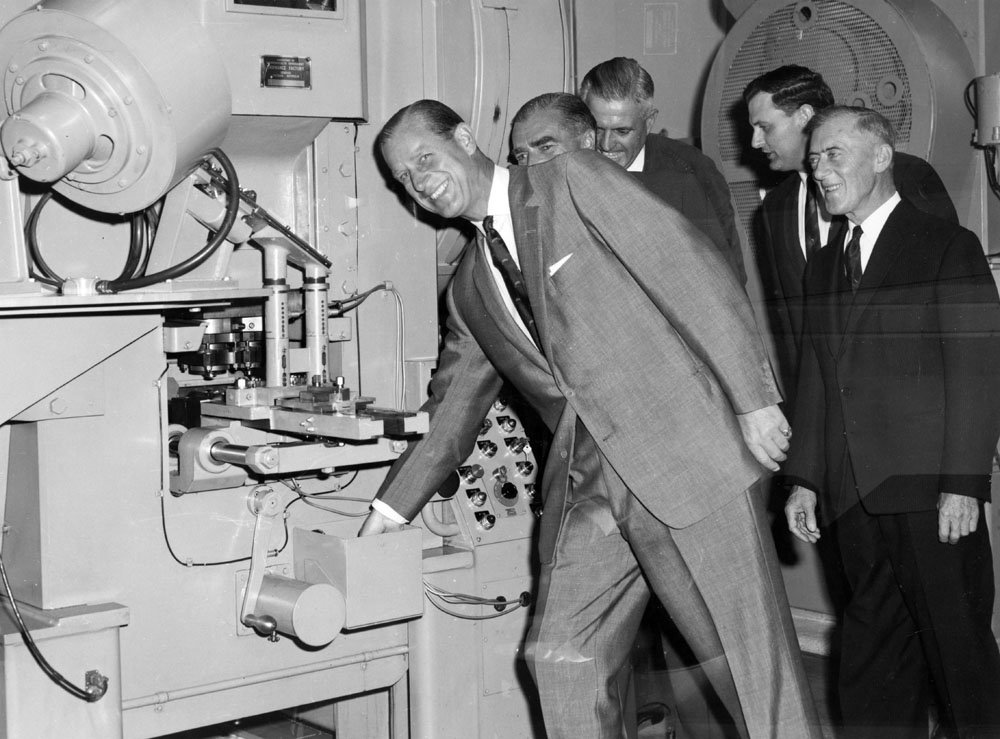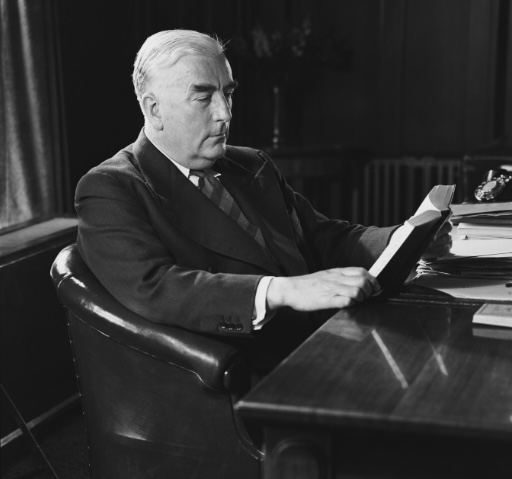On this day, 22 February 1965, the Royal Australian Mint was opened by Prince Philip. The building cost a grand total of £4.5 million, and was easily the most advanced manufacturing facility in all of Canberra – and one of the most advanced in the whole country. It was a literal embodiment of the saying that ‘you need to spend money to make money’.
The mint replaced existing mints at Sydney, Melbourne and Perth, which had all opened before federation as local subsidiaries of the United Kingdom Mint. While uniquely Australian coins had been minted by them since 1916, they carried over this attachment to the UK, and thus the Royal Australian Mint was the first completely independent mint of the Commonwealth.
The decision to create such a mint followed on from an announcement made in February 1963 that the Government intended to abandon the old imperial pound and introduce its own decimal currency, which was initially dubbed the ‘Royal’. The name was later dropped in response to a public backlash, which the Prince was savvy enough not to bring up during his speech. Instead, he focused on the marvelous native Australian animals featured on the coins, using the opportunity to make an environmental point about the need to protect them.
The Canberra Times reported extensively on the details of what it considered to be a technical marvel:
‘The Royal Australian Mint at Deakin is certainly the most self-contained factory in the A.C.T. and indeed, it is questionable whether there are many factories in the whole of Australia involving so many intermediate processes, which do everything, starting with the preparation of the raw materials and concluding with the finished article. The function of the Mint is to make money, literally the money which we spend in our day to day purchases, and one of the essentials in this process is to maintain a tight control of quality of the coinage.
The metals used are alloys made up of different metals in rigidly prescribed proportions, and as all of these are valuable—silver especially —the necessity for strict control is apparent…
A manufacturing process that involves every stage from the raw materials made it necessary to install at the Royal Mint some extremely expensive and precise machinery to a total value of £2 million and the huge electric furnaces from which pour the molten alloys into moulds which provide bars of workable size—about five feet by 12½ inches by 1¾ inches— are the major reason why the Royal Australian Mint is the greatest single user of electricity in the A.C.T.
As can be imagined, the weighing machines which are used at various stages in the manufacturing process are among the most precise available anywhere and the first indication of their importance is to be seen in the composition of the “charge” waiting to go into the furnace. On a large tray are the elements of the “charge” precisely weighed so that each element is in its correct proportion. Thus, the charge for the one and two cent pieces contains 97 per cent copper and 3 per cent zinc and tin. These are the elements which make the most humble coins of our new currency.
The five, 10 and 20 cent pieces will be composed of what is known as cupro-nickel which is 75 per cent copper and 25 per cent nickel. The, by comparison, lordly 50 cent piece will be 80 per cent silver and 20 per cent copper. The bar of alloy which comes from the furnace mounds goes to a shearing machine which cuts off the rough ends and the bar then goes through the first rolling machine which thins it and elongates it to what is known as a fillet.
Now, as every mechanic and engineer knows, copper has the peculiar property that when it is worked it becomes hard, so that the next step is to anneal or soften it by heating it again in an atmosphere freed from oxygen.
Now once more workable, the fillet goes again through the rollers to reduce it to a long thin strip which is coiled for convenience of handling. After being annealed once more the coil is passed through a finishing mill which reduces it to coin thickness controlled by an X-ray thickness gauge. Now the coil of metal goes through a “gang slitter” which trims off the rough edges and slits it into two coils each six inches wide.
It also can be mentioned here that although the machines are specialised and highly accurate, quite a number of them are made in Australia, and it is to Australian made machines (Heine’s) that the six inch wide strips now go to have the coin blanks stamped from them, eight blanks coming from them at each stroke.
These blanks are then annealed and poured into a water and sulphuric acid bath, and are washed and burnished ready, for the next step. As they pour from this machine they pass over a vibratory screen whose bed has holes through which faulty blanks can drop. The blanks, which might by now have a slight ovality, go through a marking machine which makes them perfect circles and also forms on their edges the slight rim found on all our coins.
The blanks are now ready for the coining presses which emboss on them the chosen designs for the obverse and reverse sides. These machines of which there are 12, are the product of the Commonwealth Ordnance Factory at Bendigo and are made under licence from the American Bliss Company. They can strike two of the smaller coins or one of the larger ones at a time and have an output of up to 360 coins a minute.
This is the end of the manufacturing process but not the end of the Mint’s work. First, each coin is examined for faults (on a machine which flips them over to permit both sides to be inspected) and then they go to the count and wrap machines which wrap them into rolls which are packed in bags and later on standard sized boxes. It only remains for the Reserve Bank to decide when it needs the coins for putting into circulation.
Its vehicles are admitted to a courtyard through a gate that is opened by remote control by Commonwealth security officers who can see everything that is going on, the coins are taken from the vaults, and loaded on to the bank’s vehicles.’
Sign up to our newsletter
Sign up for our monthly newsletter to hear the latest news and receive information about upcoming events.


